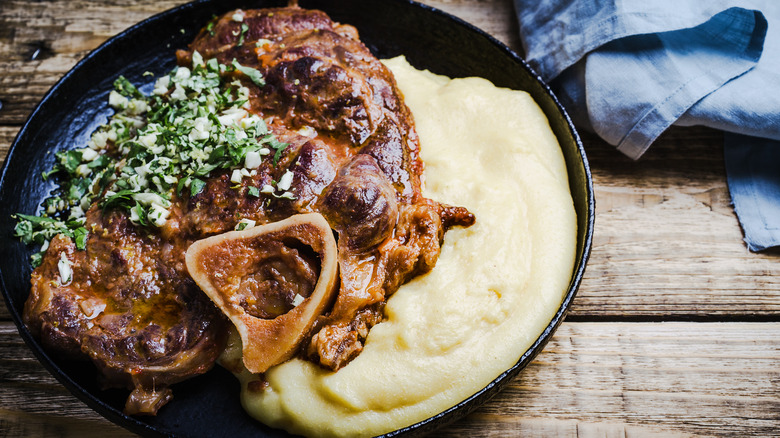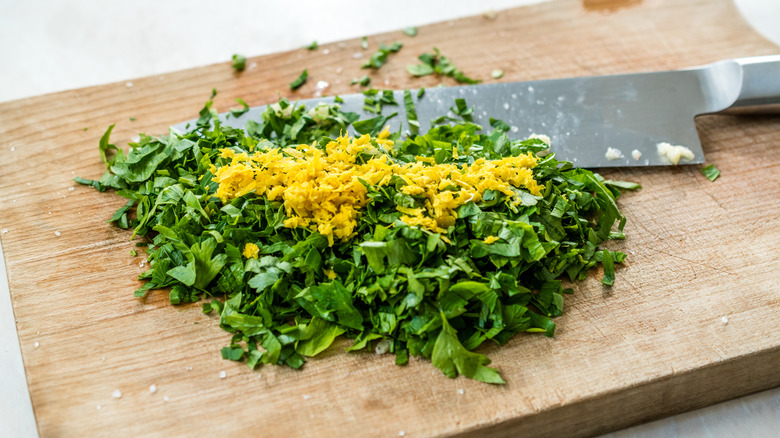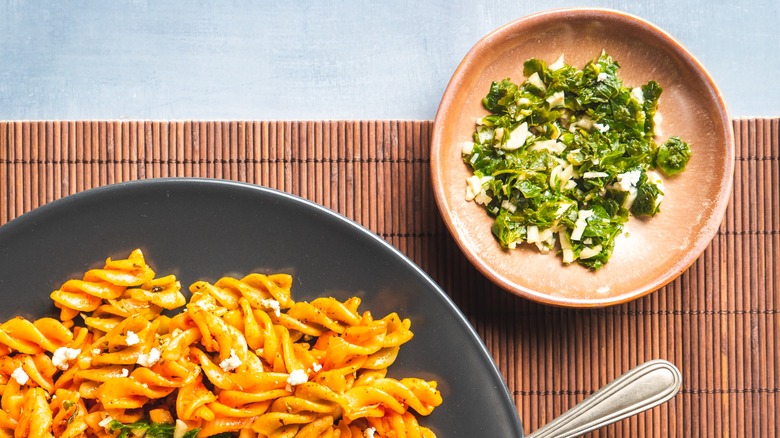The Best Flavor Additions To Amp Up A Classic Gremolata Sauce
A good gremolata can go a long way when paired with meat, fish, or roasted veggies, giving your meal an extra zing of fresh, zesty flavors. And while a classic gremolata sauce is delicious as is — pure and simple, yet packing a big punch — there are plenty of ways to amplify this freshly made condiment for an even tastier experience.
But let's back up a second ... what exactly is gremolata? Gremolata is a classic Italian condiment that's typically made up of only three ingredients: fresh parsley, garlic, and lemon zest (per Cookie and Kate). This finely chopped citrus-herb-garlic garnish is traditionally served with the Italian veal dish osso buco, but it can be used to brighten up the flavors of any type of dish, from lamb to seafood and soups to stews.
There are lots of directions you can go to make a gremolata truly stand out. So what flavors and additions work best to amp up this classic combo?
Try adding these ingredients to your next gremolata
With such a simple three-part recipe, even adding just one more ingredient to the mix can make a big difference, elevating the textures and flavors of a classic gremolata.
If you're pairing your gremolata with meat, try using other herbs in addition to the parsley that complements the flavors of the meat, like mint for lamb or rosemary for pork. If you're using the garnish to add some dimension to an otherwise bland or one-flavored dish, try including some chili flakes, crushed red pepper, or even jalapeño to crank the spice level up a notch. You can also use shallot in addition to the garlic for added flavor (or even fry them for extra crunch, if you're feeling fancy).
For added brine that goes great with lots of white fish, throw in some chopped-up capers. And for extra texture and a hint of that toasty, nutty flavor, try adding crushed walnuts or pine nuts, making for a heartier pesto-like gremolata that would taste delicious on pasta or polenta. For something more unique and out-of-the-box, Food & Wine suggests carrot tops for added greens that save unnecessary waste, or even a bold flavor addition like horseradish to make it truly unique.
How is gremolata different from pesto or chimichurri?
When it comes to green, herby garnishes, there are lots of cousin condiments out there that seem similar. So what's the difference between gremolata and these other herb-based sauces like pesto and chimichurri?
According to Two Peas and Their Pod, chimichurri (which hails from Argentina) is similar in that it also uses garlic and parsley in its base, but it also includes olive oil and red wine vinegar — which sets it apart and makes it tangy. Pesto, on the other hand, is classically made with basil, olive oil, garlic, pine nuts, and parmesan cheese; so while it's also green and herby, it tends to be a little heavier and creamier.
It all comes down to the simplicity of gremolata. While many add olive oil to make it saucier, in its purest form gremolata is only made from three ingredients that are meant to perfectly balance each other out: garlic, lemon zest, and parsley. The key is using ingredients that are as fresh as possible for a condiment that's bright, herby, and zesty all at once.


